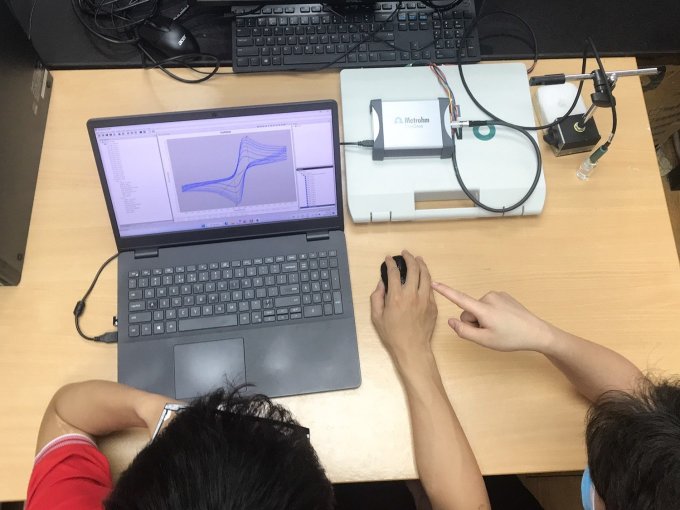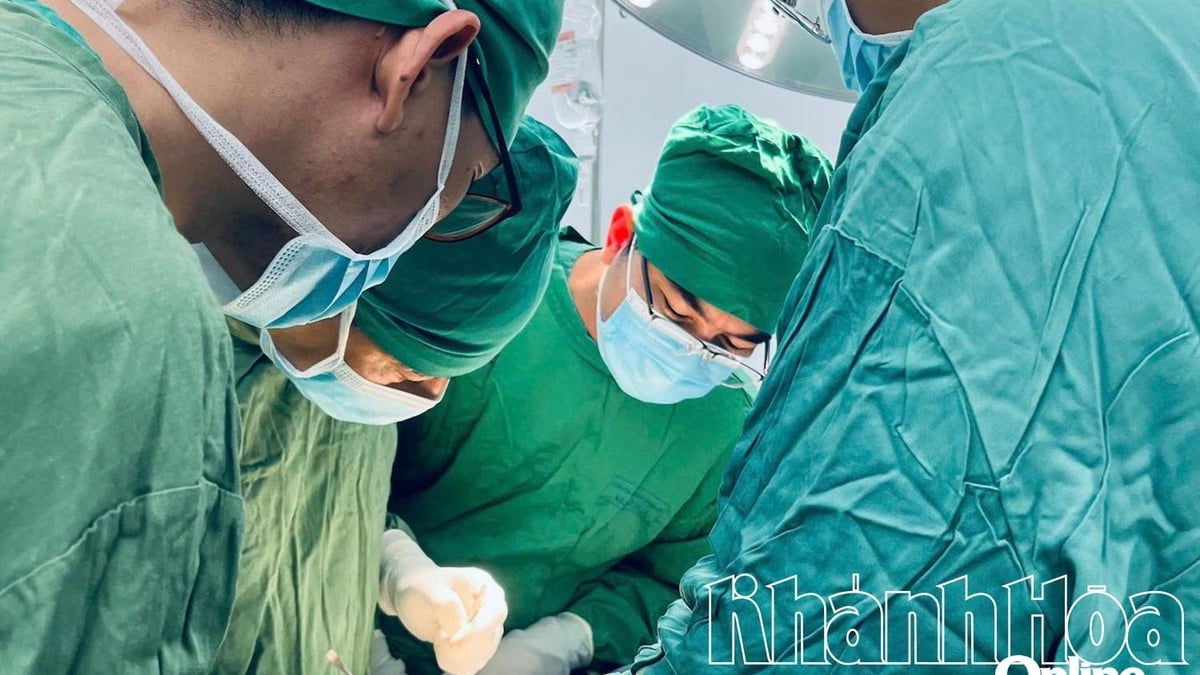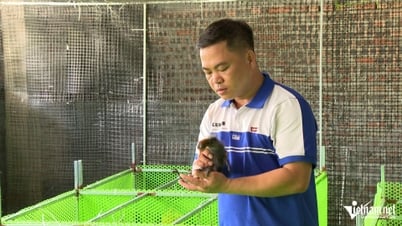Applying electrochemical sensor technology, a group of students from the University of Technology (VNU) developed a device that can determine antibiotic residues in milk, meat, seafood... at low concentrations.
Since August 2022, Tran Van Dinh and Nguyen Van Khanh, students of class K65, University of Technology, have begun researching the process of determining residues of the antibiotic Chloramphenicol (CAP) in food based on electrochemical analysis techniques.
Tran Van Dinh, representative of the research team, said that the material used by the team in the study is superparamagnetic Fe3O4 nanoparticles, used to modify the electrode of the electrochemical sensor, thereby improving the performance and enhancing the detection signal of CAP antibiotic residues in food at low concentrations.
Superparamagnetic Fe3O4 nanoparticles were selected for their high electrical conductivity, chemical stability and superior electrochemical performance. In particular, Fe3O4 particles have good biocompatibility, high adsorption capacity for organic substances such as CAP in food and low production cost.

CV curve is used to measure the sensitivity and signal of the sensor when the electrochemical device is connected to the computer. Photo: NVCC
Under the guidance of the lecturers, in 7 months, the research team designed a device with 3-electrode sensor technology with three functions (working, comparing and referencing). The device is built on the principle of electrochemical sensors interacting with antibiotics. The changes in this interaction will be recorded on the electrochemical measurement system.
Specifically, the superparamagnetic Fe3O4 nanoparticles on the working electrode of the sensor will interact with the antibiotic CAP in the food sample. As soon as the interaction occurs, the electrochemical parameters and resistance of the sensor will change. This change is recorded and then fed into the measurement and control system.
Through measuring devices and signal analysis methods, the measured values through the sensor are processed and analyzed, thereby determining the residue of CAP antibiotics in food samples. The time for an analysis usually lasts from 3-5 minutes.
To use, food samples such as meat, seafood... are prepared and processed for screening. Next, the food sample is put into an electrochemical sensor connected to an electrochemical measuring system to record and process the signal.
As a result, the device detected 5μm of CAP residue in milk samples and 25μm in meat samples, along with some other food samples such as shrimp, fish, water sources... The allowable antibiotic residue in most common foods is at 0.3μm.
Dinh added that to apply this electrochemical sensor technology device, it is necessary to perform some sample preparation procedures. These steps are performed in the laboratory.
The research team hopes that in the future, with the development of technology and further research, the product will be improved into a compact device or test strip. From there, people can check antibiotic residues in food at home without having to go to the laboratory or have special expertise. When the product is commercialized, it will contribute to controlling food quality and protecting people's health.
Dr. Nguyen Thi Minh Hong, Lecturer of the Faculty of Engineering Physics and Nanotechnology, University of Technology, assessed that currently, the analysis and determination of toxic antibiotic residues are often conducted by a number of methods such as thin layer chromatography, capillary electrophoresis, immunosorbent assay, optical biosensors... Despite their high efficiency, sensitivity and many other advantages, most of these methods cannot be directly applied to detect antibiotics, because they require complex operations and implementation processes, high costs, time-consuming, and require many conditions during sample preparation.
Dr. Hong said that label-free electrochemical analysis techniques based on electrochemical sensors are considered a potential solution thanks to their simple analysis process, fast response, high sensitivity and selectivity, and low analysis cost. The group's research results are very promising, achieving the set goals, having good practical application potential, and can continue to be developed.
She suggested that the student group's research topic could help units, authorities and businesses apply it in tracing and controlling food quality.
Currently, the research team continues to conduct further research and develop magnetic nanomaterials to modify electrodes, optimize the manufacturing process and improve the properties of electrochemical sensors. "The modified materials will be tested with nanomaterials manufactured by different methods, changing the technological conditions to improve electrochemical performance, sensitivity and selectivity to detect a variety of antibiotics and toxic substances," said Dr. Hong.
Studies show that the uncontrolled abuse of CAP antibiotics in livestock and farming has led to the situation where food still contains antibiotic residues. Using food with residual antibiotics for a long time or using it continuously can cause poisoning of the body, bone marrow aplasia leading to anemia, leukemia and Grey-syndrome causing cyanosis, circulatory collapse and can cause death, commonly seen in newborns, especially premature babies...
Bich Thao
Source link






























































































![[Infographic] In 2025, 47 products will achieve national OCOP](https://vphoto.vietnam.vn/thumb/402x226/vietnam/resource/IMAGE/2025/7/16/5d672398b0744db3ab920e05db8e5b7d)





Comment (0)